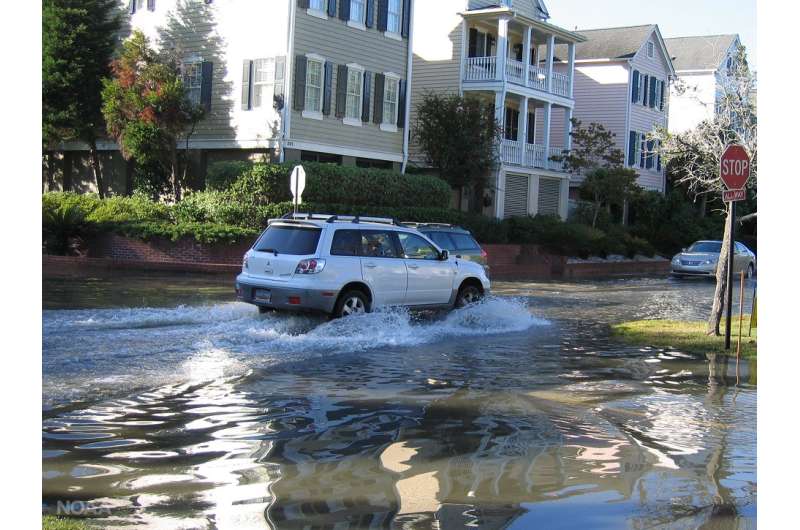Regional sea-level scenarios will help Northeast plan for faster-than-global rise

Sea level in the Northeast and in some other U.S. regions will rise significantly faster than the global average, according to a report released by the National Oceanic and Atmospheric Administration (NOAA).
Moreover, in a worst-case scenario, global sea level could rise by about 8 feet by 2100. Robert E. Kopp, an associate professor in the Department of Earth and Planetary Sciences at Rutgers University, coauthored the report, which lays out six scenarios intended to inform national and regional planning.
"Currently, about 6 million Americans live within about 6 feet of the sea level, and they are potentially vulnerable to permanent flooding in this century. Well before that happens, though, many areas are already starting to flood more frequently," said Kopp, who leads Rutgers' new Coastal Climate Risk and Resilience graduate traineeship. "Considering possible levels of sea-level rise and their consequences is crucial to risk management."
The report, "Global and Regional Sea Level Rise Scenarios for the United States," provides regional sea-level rise scenarios and tools for coastal preparedness planning and risk management. It also reviews recent scientific literature on "worst-case" global average sea-level projections and on the potential for rapid ice melt in Greenland and Antarctica.
The report's authors, who also include scientists from federal agencies, Columbia University and the South Florida Water Management District, concluded that evidence supports a "worst-case" global average sea-level rise of about 8.2 feet by 2100. Recent studies on Antarctic ice-sheet instability indicate that such rises may be more likely than once thought, the report says.
The report provides a range of possible scenarios, from at least 1 foot of global sea-level rise by 2100 to a worst-case rise that's 1.6 feet higher than a scenario in a key 2012 study that the report updates. The report also provides four additional global average sea-level rise scenarios through 2100: intermediate-low (1.6 feet); intermediate (3.3 feet); intermediate-high (4.9 feet); and high (6.6 feet).

The scenarios were also tailored to produce regional projections in areas including the U.S. Atlantic, Gulf of Mexico and Pacific coasts, Alaska, Hawaii, the Caribbean and Pacific island territories.
"The report's detailed local scenarios represent a significant advance in the federal government's response to requests by states and cities for more information tailored to their location," Kopp said.
Key findings from the report include:
- From Virginia through Maine and along the western Gulf of Mexico, sea-level rise is projected to be greater than the global average in nearly all global average sea level rise scenarios. For example, the sea in these regions would rise 1 to 1.6 feet higher than the global average rise of 3.3 feet under the intermediate scenario by 2100.
- Along almost all U.S. coasts outside Alaska, sea-level rise is projected to be higher than the global average under the intermediate-high, high and extreme scenarios. For example, the sea level would be 1 to 3.3 feet higher than the global level under the high scenario.
- Along much of the Pacific Northwest and Alaska coasts, sea-level rise is projected to be less than the global average under the low-to-intermediate scenarios. For example, the rise would be 0.3 to 3.3 feet lower than global rise under the intermediate scenario.
The report also focuses on the frequency of moderate-level flooding that triggers a NOAA coastal/lakeshore flood warning of a serious risk to life and property. In general, the water level that triggers a warning is about 2.6 feet above the highest average tide and has a 20 percent chance of arising each year.
With less than 14 inches of sea-level rise, most of the 90 U.S. coastal cities studied outside of Alaska would see a 25-fold increase in disruptive and damaging flooding by around 2080, 2060, 2040 or 2030 under the low, intermediate-low, intermediate and intermediate-high scenarios, respectively. That means a once-in-five-year flood would happen five times a year, on average.
"That's a transition when flooding that used to be driven by storms becomes flooding driven by extreme high tides," Kopp said. "Along the Jersey Shore, that transition would happen in the 2060s under the intermediate scenario and the 2030s under the intermediate-high scenario."
More information: www.noaa.gov/media-release/new … es-prepare-for-risks
Provided by Rutgers University


















